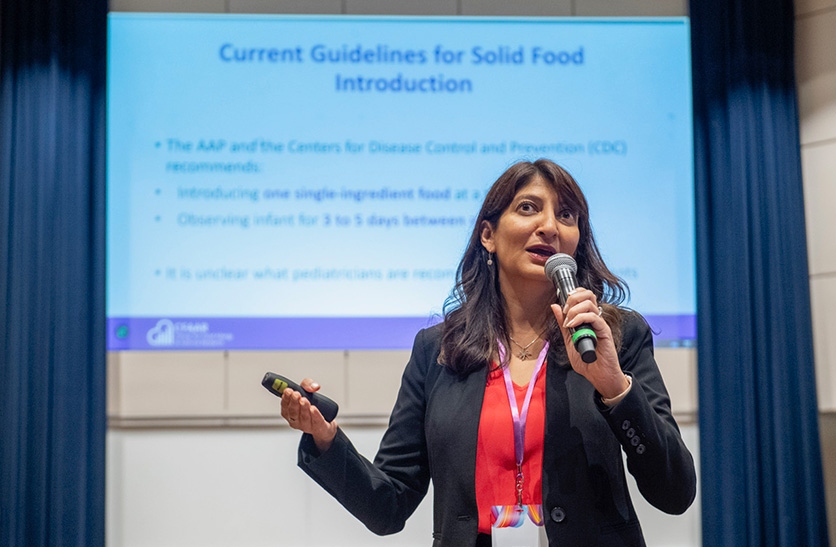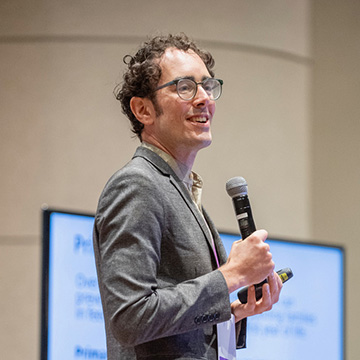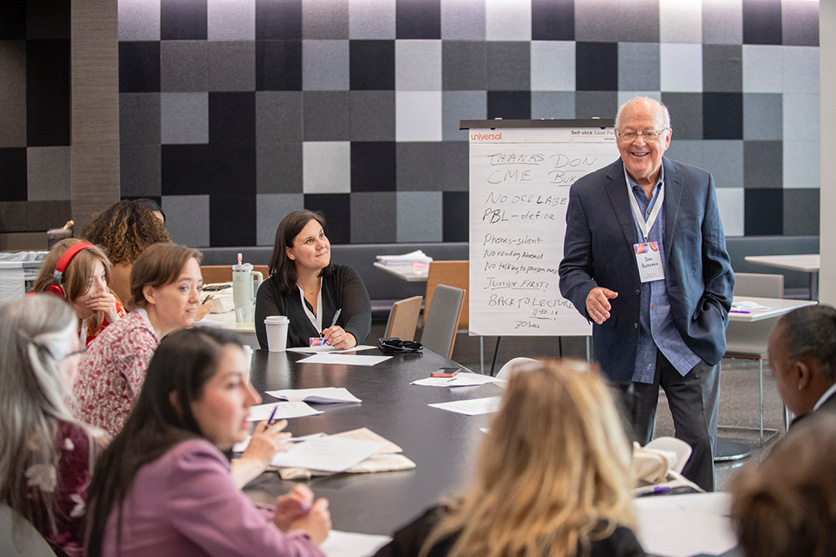A Catalyst for Change: CFAAR’s 2025 Food Allergy Summit Shapes the Future of Food Allergy Care

July 7, 2025
By Ariana Freeman and Emmeline E Perry
Northwestern University’s Center for Food Allergy and Asthma Research (CFAAR) welcomed clinicians, researchers, and advocates from across the globe to its third annual Food Allergy Summit held on the weekend of June 27.
Attendees travelled from as far as Australia, Japan, and England to participate in the event, offering their perspectives as allergists, pediatric care providers, researchers, patient advocates, and industry partners.
Ruchi Gupta, MD, MPH, founder and director of CFAAR, opened the weekend by welcoming participants and highlighting the importance of the global gathering.
“Our mission, and the reason we’re all here, is to support those with atopic conditions,” Gupta said. “There are millions of people living with food allergies, and each of us understands the burden that puts on families. Today is about taking leaps forward and changing their lives for the better.”
Designed as a hub for interdisciplinary dialogue and collaborative problem-solving in food allergy care, this year’s summit was comprised of three innovative tracks: Policy, Pediatric Education, and Prevention.
Christopher M Warren, PhD, assistant professor of Preventive Medicine and director of Population Health Research at CFAAR, spoke on the importance of the weekend’s discussions.
"Amid a changing public health and regulatory landscape, it is more important than ever for the full range of food allergy prevention stakeholders to connect,” Warren said. “Through these meetings we are enabling a future where food allergies are prevented long before they become a burden."

Through these meetings we are enabling a future where food allergies are prevented long before they become a burden.”
Emerging Trends in pediatric allergy care
Among the running themes of the summit’s Pediatric track was the interconnectivity of allergic disease and a particular focus on the microbiome.
Richard Insel, MD, global head of the Healthy Baby Initiative, presented striking discoveries gleaned from recent studies on the global decrease of certain bacteria known to support healthy immune development in infants.
“If we look at the non-industrialized world, we've seen over the last decade or so, loss, disappearance of B. infantis,” Insel said. “Why is that? We know for sure that many of those things are related to antibiotics, C-section delivery, lack of breastfeeding, and even transgenerational effects where the mothers of today have not passed the bifidobacteria babies on to their babies.”
According to Insel, 25% of infants tested in a recent study had no bifidobacteria and around 50% had severely depleted levels of bifidobacteria. These changes, Insel emphasized, are being observed at the genus level.
“The fact that the genus was missing in a quarter of the babies was really quite striking,” Insel said, and highlighted that children born with low levels of bifidobacterium appeared to have a three times higher risk of developing allergic disease.
This drastic drop-off in healthy microbiota sparked further discussion on potential solutions, including lifestyle interventions for expectant mothers. Reducing maternal stress, which is thought to play a role in gut function and prenatal development, was a popular suggestion across the board.
Impacting food allergy through policy
Evidence-based policy was front and center as stakeholders gathered Friday to confront gaps in food allergy care and propose new paths forward.
Ron Ackermann, MD, MPH, director of Northwestern’s Institute for Public Health and Medicine (IPHAM), opened the discussion with a powerful keynote that challenged traditional approaches to policymaking.
“When we collaborate and share information openly, and we have respectful relationships with one another where we explain the method we’re using and why we came to a different conclusion, it allows us to understand each other’s perspective more, and that is where innovation happens,” Ackermann said.

When we collaborate and share information openly... it allows us to understand each other’s perspective more, and that is where innovation happens.”
That message was echoed throughout that day as discussions focused on what makes effective policy: collaboration, the integration of diverse voices, and transparency.
Following the keynote, attendees participated in dynamic working groups: Precautionary Allergen Labeling (PAL), Medicaid and Early Introduction Access, and Educational Safety Policies.
Perhaps no topic garnered a more animated discussion than the Precautionary Allergen Labeling (PAL) group. The current landscape was described by one participant as “the wild west” since the FDA does not currently regulate PAL statements, resulting in widespread inconsistent labeling practices.
Mark Park, corporate compliance manager at Franz Family Bakery in Portland, Oregon, spoke candidly about the industry’s dilemma stating.
“My job is to protect consumers from sickness no matter what it is, so how do I do that in the safest way?” Park said. “We want a mandatory system because we want the certainty that comes with it. We want to be able to say that we are following the prescribed process and that is why our label says what it says.”
Several industry representatives attending the summit voiced support for stronger oversight.
Sarah Sorscher, JD, MPH, from the Center for Science in the Public Interest, noted the growing global momentum.
“There is a huge global community interested in better systems for PAL consistency,” Sorscher said, citing countries like Australia and New Zealand that have adopted standardized frameworks such as the VITAL system. Other countries, including Japan, have their own allergen labeling regulations as standardized PAL systems are evolving globally.

The Medicaid and Early Introduction Access group explored how federal nutrition and healthcare programs play a pivotal role in supporting early allergen introduction. Group discussions focused on key programs such as Medicaid, Women, Infants and Children (WIC), and emerging “food as medicine” models, aiming to bridge the gap between nutrition and health outcomes. Participants emphasized the need to align these programs with the latest clinical research. One participant highlighted the delay between new research and updates to WIC’s food basket recommendations, which can lag as much as ten years.
The Educational Safety Policies working group analyzed food allergy safety across daycares, K-12 schools, and college campuses. Led by Jen Jobrack from Food Allergy Pros, the group addressed the pressing concern that most existing protections for students with food allergies remain voluntary and inconsistently implemented.
“Most of these laws do not have an enforcement mechanism or data collection component to understand how effective the laws are,” Jobrack said. She explained that whilst states are permitted to have epinephrine on-hand for emergency use, stocking it is often voluntary and not required. This leads to inconsistent protections across educational settings. A child’s ZIP code is often indicative of the educational materials, level of staff training, and access to life-saving medication.
Research on the horizon
The Prevention Track, held on Saturday and Sunday, gathered researchers for a close discussion of several key studies, including the CANDO Study, LEAP-Trio Study, and efforts to refine criteria for infant and toddler anaphylaxis.
Updates were also presented on the Barwon Infant Study, the PEBBLES Trial, and the PrEggNut Study.
Among the key initiatives discussed was the development of the Food Allergy Data Dictionary (FADD) and Common Data Elements (CDEs). With 936 validated food allergy concepts developed, this standardized framework aims to unify clinical documentation and enable large-scale, collaborative food allergy research.
Sai R Nimmagadda, MD, associate professor of Pediatrics and chief allergist at CFAAR, closed the weekend by reflecting on the summit’s broader impact.
"The CFAAR Summit is more than a gathering of leaders in the field of allergy — it's a catalyst for change, driving early intervention strategies, advancing food allergy prevention, and a call to action for policy shifts," Nimmagadda said. "The future of food allergy prevention is driven by compassion in action, driven by collaboration, leading to prevention strategies being adopted and implemented for all children. Together, we can build a world where food nourishes everyone."